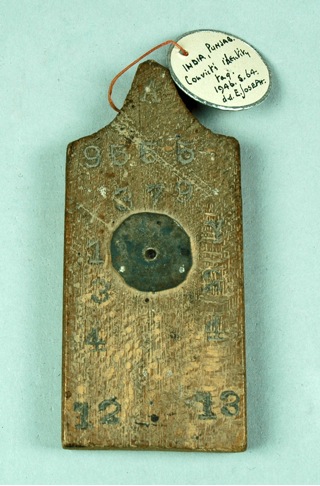Prisoner's tag
India or Pakistan
 Donated by E. Joseph in 1946; 1946.5.64In most cases, status ornaments are worn voluntarily to show to the wider world your achievements, social position or wealth. However, some markers identify you as something you do not want to be and indicate a low social status imposed by others. Prisoner's tags are a common manifestation of this idea; this example was collected in the Punjab area of India and Pakistan in the early 20th century. It is made of wood with a metal disc nailed to it and is stamped with numbers. The quantity of numbers suggests the tag may have been recycled to indentify several prisoners over time.
Donated by E. Joseph in 1946; 1946.5.64In most cases, status ornaments are worn voluntarily to show to the wider world your achievements, social position or wealth. However, some markers identify you as something you do not want to be and indicate a low social status imposed by others. Prisoner's tags are a common manifestation of this idea; this example was collected in the Punjab area of India and Pakistan in the early 20th century. It is made of wood with a metal disc nailed to it and is stamped with numbers. The quantity of numbers suggests the tag may have been recycled to indentify several prisoners over time.
In the history of crime and punishment, the concept of imprisonment as a long-term punishment is relatively recent although the identification of persons of low status is not. Branding and tattooing were permanent ways of assigning someone a number or identity, effectively denying them of their personal identity and turning them into property. In Ancient Rome, slaves were branded or tattooed with the marks of their owners and if they ran away, lied or thieved, they would be branded on the face with the letters 'FUG', 'KAL', or 'FUR' for fure meaning 'thief', kalumnia meaning 'lie' and fugitivus meaning 'runaway', respectively. Criminals were tattooed in Japan until the end of the 17th century and 16th-century German Anabaptists were branded on their foreheads with a cross for refusing to recant their faith. In Britain felons who received 'benefit of clergy' for lesser crimes or in return for a godly confession had, since medieval times, been branded on the thumb so they could not receive the benefit again. Branding was used to mark those sentenced to transportation, for example from Britain to Australia or from Russia to Siberia, whilst in France under the Bourbon kings, convicts were branded with a prisoner number on the chest. The last convict sentenced to branding in Britain was at the Old Bailey court in 1789.
In ancient and medieval times, dungeons and jails existed as a short-term holding place for malefactors and political opponents. However, it was not until the 18th century that prisons became organised institutions in Europe. One of the first prisons to replace inmates' names with a number, which was to be used in all paperwork and communications relating to that individual, was Pentonville in Britain. Opened in 1842, Pentonville was characteristic of a new type of prison built and run according to the 'separate system', aimed to reform rather than punish. The inmates were kept under tight control and prevented from associating with one another. Known only by their numbers, attached to their uniforms on badges or tags, they were kept in identical cells, ate the same food, worked the same relentless treadmills, dressed in the same uniforms, and were even made to wear face-coverings when they came out of the cells.
Other countries adopted similar models in the 19th century. In the United States, for example, prisons in Pittsburgh and Philadelphia were built according to a modified version of the separate system, known as the 'Pennsylvania plan'. In India, the current prison system is a legacy of British rule. Pre-colonial Indian law was based on Hindu or Islamic statues but the British supplanted this with common law. In 1836, Lord Macaulay recommended more rigorous regulations of existing prisons and over the next hundred years, dozens of British-style prisons were built. The Prison Act of 1894 still forms the basis of India's present penal management and administration.
